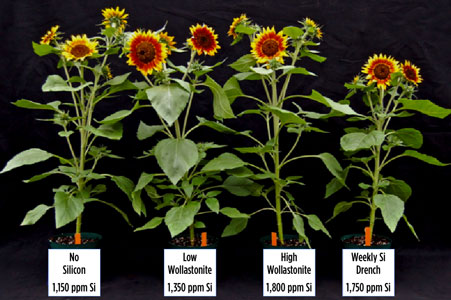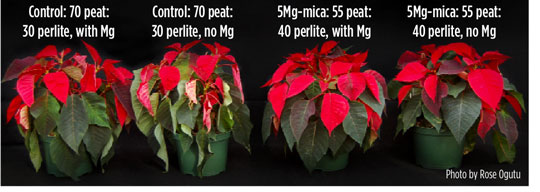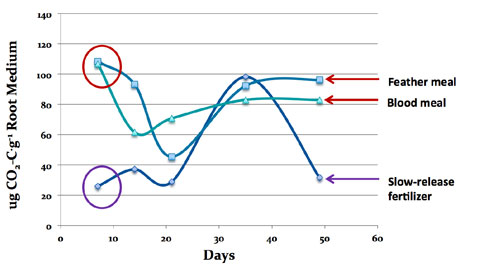1/25/2012
Research Report
Dr. Kim Williams
Is it possible to improve on the greenhouse industry’s tried-and-true fertilizers and root media? There’s always opportunity for improvement! Following are some of the new twists on old ideas that are afoot with soilless root media and fertilizer research at Kansas State University.
Silicon. Benefits from soluble silicon drenches to crops that accumulate it have been well documented. But what about incorporating a solid form of silicon into soilless root media that solubilizes during production so that no drenches are required? SunGro Horticulture holds a patent on the use of wollastonite, a calcium silicate mineral, in root media. The material can be incorporated into a root medium during the formulation process and dissolves during the crop production cycle for uptake by the plant. In trials at Kansas State University, wollastonite incorporation resulted in silicon concentrations in sunflower tissue that were comparable to a weekly drench with potassium silicate (Figure 1). And its use may offset the amount of limestone needed in the mix.
 Figure 1. Levels of silicon in the leaf tissue are indicated for these Ring of Fire sunflowers that were grown in a root medium with 2.5 g dolomitic lime per liter of mix; the low and high rates of wollastonite were 1.5 and 3.0 g per liter, respectively.
Struvite.
Figure 1. Levels of silicon in the leaf tissue are indicated for these Ring of Fire sunflowers that were grown in a root medium with 2.5 g dolomitic lime per liter of mix; the low and high rates of wollastonite were 1.5 and 3.0 g per liter, respectively.
Struvite. Magnesium ammonium phosphate is an old, slowly soluble fertilizer that was originally manufactured from mined rock phosphate and traditionally used more by the nursery rather than greenhouse industry. Currently, the ability to manufacture struvite from phosphorus recovered from wastewater is giving the fertilizer new life. At Kansas State University, a nutrient release trial with struvite pellets (approximately 3.5 N:24 P2O5:2.5 K2O:13.5 Ca:10 Mg) generated from feedlot waste streams yielded nutrient release patterns fairly comparable to MagAmpK (7 N:40 P2O5:6 K2O:15 Mg; Sumitomo Corp.), though frequently with a little lower phosphate concentrations recovered via pour-through extractions (Tables 1 and 2)—this is a good thing, as phosphate levels are still adequate for optimal plant growth, but less phosphate will be available for leaching.
 Tables 1 and 2. Levels of phosphate measured in the root medium solution from fallow pots with MagAmpK
Tables 1 and 2. Levels of phosphate measured in the root medium solution from fallow pots with MagAmpK
(purple lines) versus struvite (green lines) are shown for a peat-based mix (top) versus a bark-based mix (bottom). The materials were incorporated at a rate of 0.12 g P per liter of root medium.
Clays. The use of clays as an amendment in soilless root media offers three potential advantages: phosphate (and other nutrient) retention, a decrease in water use, and function as a natural wetting agent. In trials at Kansas State University with the clay lamproite (Mg-mica; Micro-Lite, Chanute, KS) incorporated at a rate of 5% of the root medium, we have measured significant benefits of water savings. For example, using 5% Mg-mica clay in a peat-based root medium for 5-in. poinsettia production resulted in more water remaining in the pot after each irrigation compared to a 70 peat:30 perlite control. In a nutshell, with the clay in the mix, 88% of the water applied stayed in the container, versus 72% for the peat and perlite mix.
 Figure 2. The two poinsettias on the right were produced in a mix of 5 Mg-mica : 55 sphagnum peat : 40 perlite, and control plants on the left were produced in 70 sphagnum peat : 30 perlite. After saturating all pots, those without Mg-mica clay in the mix (left) became water-stressed more rapidly because the mix did not retain as much water. Over the course of the production cycle, they required 23% more water for healthy production.
Figure 2. The two poinsettias on the right were produced in a mix of 5 Mg-mica : 55 sphagnum peat : 40 perlite, and control plants on the left were produced in 70 sphagnum peat : 30 perlite. After saturating all pots, those without Mg-mica clay in the mix (left) became water-stressed more rapidly because the mix did not retain as much water. Over the course of the production cycle, they required 23% more water for healthy production.
Because the amended mix retained more water, less leached from the pot. In the same experiment, about 16% less water leached from containers that contained clay in the mix compared to the peat and perlite control. Finally, fewer irrigation events were needed for poinsettias produced in the clay-containing mix compared to the control over the course of the production cycle (Figure 2). This alone resulted in a 23% water savings compared to plants produced in the peat and perlite mix. A useful extrapolation of using a root medium with improved water retention is that mature plants may require less frequent irrigation, therefore performing better in the market channel and in consumers’ care.
Microbial inoculants. Do microbial inoculants provide measurable benefits when used with soilless root media? We are trying to answer that question. In a recent study with impatiens produced both with and without inoculation at planting with a commercial inoculant, we observed that while the artificial inoculation did not increase microbial activity in the root medium, populations of the naturally occurring microorganisms involved in nutrient cycling peaked between 30 and 40 days of the production cycle. Another interesting observation was that seven days into the production cycle, microbial activity was much higher for plants that were fertilized with organic nutrient sources of feather meal or blood meal compared to an inorganic slow-release fertilizer (Table 3).
 Table 3. Microbial activity was measured in the peat-based root medium of an impatiens crop over the course of the production cycle. An interesting observation is that when plants were fertilized with the organic fertilizers feather meal or blood meal, microbial activity was higher after seven days of the cropping cycle compared to use of an inorganic slow-release fertilizer.
Table 3. Microbial activity was measured in the peat-based root medium of an impatiens crop over the course of the production cycle. An interesting observation is that when plants were fertilized with the organic fertilizers feather meal or blood meal, microbial activity was higher after seven days of the cropping cycle compared to use of an inorganic slow-release fertilizer.
Alternatives to perlite. A number of researchers across the United States are evaluating less expensive, locally available root medium components to replace some of the old standards. In particular, the comparatively high cost of perlite makes it a candidate for replacement. Some wood-based materials are showing promise for their ability to replace perlite by meeting the aeration function in soilless root media. As an example, in on-going research at Kansas State University, chipped Eastern Red Cedar—which is an invasive weed species in the Midwest—is showing promise as a replacement for perlite in container substrates.
New developments in greenhouse fertilizers and root media are trending towards sustainability. As an industry, we are seeking ways to reduce our use of water and nutrients, reuse and/or recycle the water and nutrients in society’s waste streams, and incorporate more locally available components into our mixes.
GT
Kimberly A. Williams is a Professor of Horticulture at Kansas State University in Manhattan, Kansas. She can be reached at kwilliam@ksu.edu. Others involved in the research presented in this article are: Jason Nelson, Rose Ogutu, Zach Starr, and Cheryl Boyer at Kansas State University. We gratefully acknowledge the Gloeckner Foundation for supporting our research.